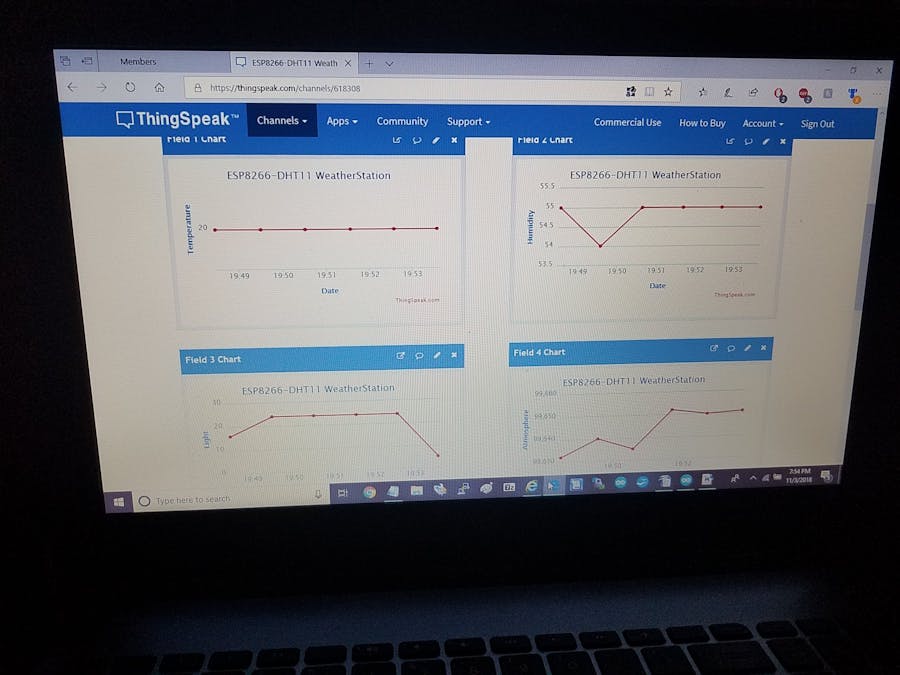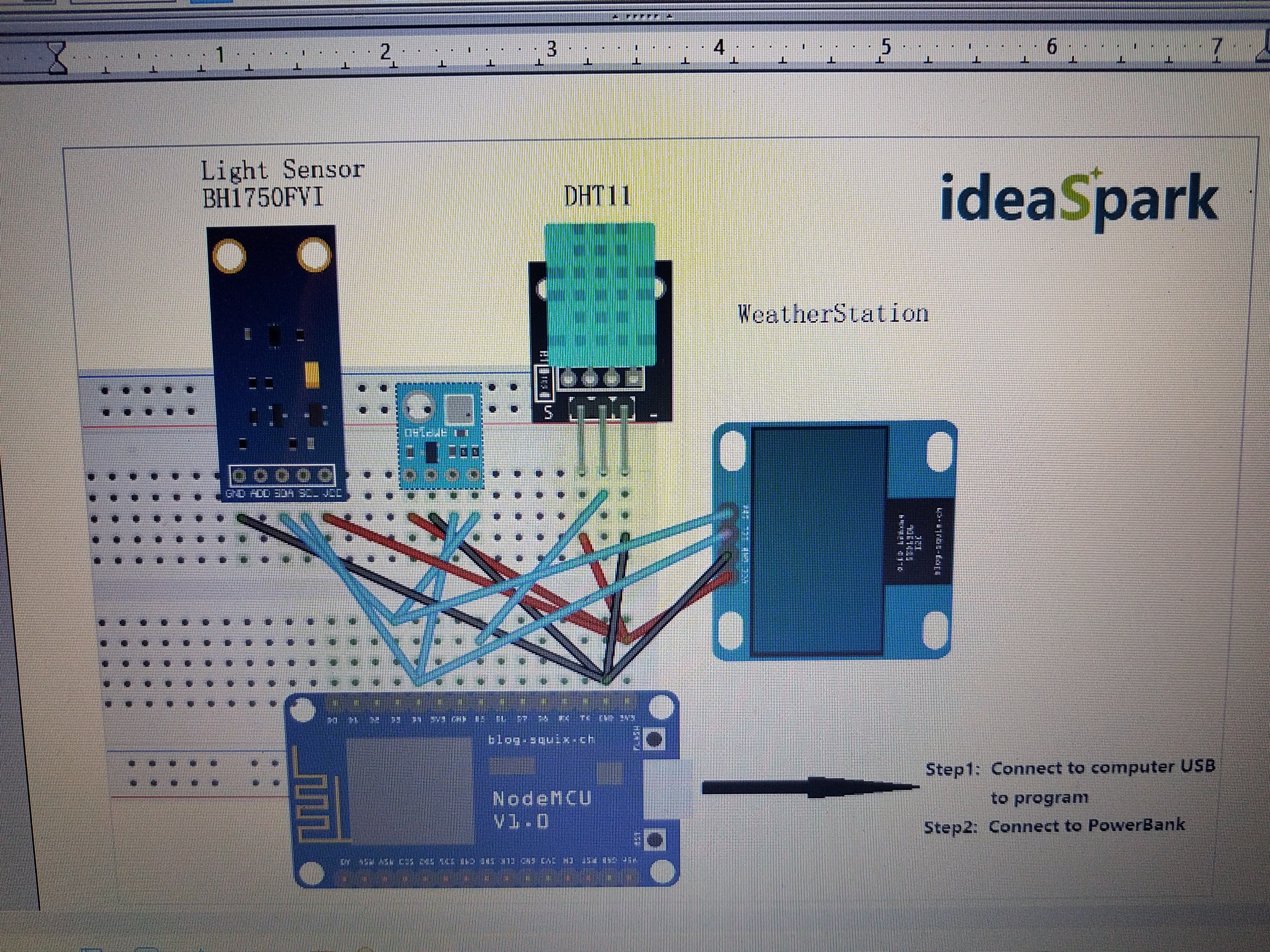What Do I Build Next? A Weather Station. I've seen these kits advertised on Amazon and Ebay and the likes. They measure temperature, humidity, barometric pressure and light levels. This one was a little different, it would also give you a three day forecast.... now I'm a weatherman. I can't do any worse than those on TV.
The Amazon store "Ideaspark" sent me an email the day after I placed my order with a link to an AMAZON drive account that had all required software and documents required. So I was able to download and review before I actually had the weather station kit. Imagine that I thought, buying something electronic from Amazon and it included complete instructions and software that was bug-free.
The processing power comes from an ESP8266 module and is linked to the internet through two "api" free accounts using "json" calls: one is on "thingspeak.com" and the other is on "openweathermap.org".
The software setup for these accounts are spelled out clearly in the kit that I purchased. Assembly of the kit was a little unclear, pictures of the interconnect wiring between each module were not that concise and the schematic was slightly better. The components were wired up using a bread board (my kit provided two mini bread boards but I wanted slightly more stability and used a larger single board) and many male-male duplex jumper wires.
The Amazon Product description is as follows:
- ✔️The weather station uses the ESP8266-12E to obtain data from the Internet: time of a city, weather data and forecast information for the next 3 days, scrolling on the SSD1306 OLED Display; the device can switch to display data from any city in the world - maybe your relatives or friends live there
- ✔️The device uses sensors DHT11, BMP180, BH1750FVI to collect temperature, humidity, Atmosphetic Pressure and light data. The weather station reads data indoor via sensor every 5 seconds and uploads it to the Internet every 60 seconds.You can see real-time data charts from your phone or computer.Of course you can modify the code to implement different functions
- ✔️【ESP8266】:CP2102 chip inside, Micro USB, 4MB flash, full I/O port and wireless 802.11 supported IOT platform Arduino compatible. 【DHT11】 Sensor: A digital signal output with a calibrated temperature and humidity combined sensor.The simple communication protocol greatly reduces the programming effort required
- ✔️【BMP180】:high-precision, small size, ultra-low power 3μA pressure sensor.Its performance excellence, the absolute accuracy of the lowest can reach 0.03hPa.Can directly through the I2C bus connected with a variety of microprocessors.Pressure range: 300 ~ 1100hPa. 【BH1750FVI】:Digital Light intensity Sensor.Direct digital output, complex calculation is omitted, omitting calibration. 【OLED Yellow Blue Display】:0.96" SSD1306 128X64 Yellow&Blue OLED LCD Display with I2C IIC SPI Serial
- ✔️We have prepared weather station hardware.And free 50M guidance manual, demo code, burning tools, necessary class libraries already on CD-ROM disk.or contact us on Amazon, we will send download link to you.Package List:1 x Esp8266-12E, 1 x DHT11, 1 x BMP180, 1xBH1750FVI, 1 x OLED Display, 2 x breadboard, 20 x dupont cable, 1 x usb cable, 1xGuidance document CD-ROM disk
Color:Weather Station Kits
Important Notice:⭐Kits designed only for Windows OS⭐The Free 50M Guidance Document:Guidance Manual, Demo Code, Burning Tools, and Necessary Class Libraries already on CD-ROM disk.Or contact us on Amazon, we will send download link on:US Eastern Time(ET): 21:00 PM - 5:30 AM(Second Day)Pacific Standard Time(PST): 18:00 PM - 2:30 AM(Second Day)Result:1) Read the temperature and humidity in the air at regular intervals2) Read the light intensity at regular intervals3) Display the humidity, temperature, light intensity in the OLED display4) Upload humidity, temperature, light intensity data to thinkspeak at regular intervals.
5)You can view it on your computer or mobile phoneGuidance Manual Catalog:Overview:This manual describes how to make a Weatherstation by Arduino IDEStep 1: Install USB-To-SerialStep 2: Install Arduino IDE for ESP8266Step 3: Burning Firmware to ESP8266Step 4: Connecting ComponentsStep 5: Register thingspeak new accountStep 6: Import Weatherstation code in the Arduino IDEStep 7: Add LibraryStep 8: Modify File Weatherstation.inoStep 9: Set the Board and Port againStep 10: Burn code to ESP8266Step 11: ResultAT-Firmware in Guidance Document:Ai-Thinker_ESP8266_DOUT_8Mbit_v1.5.4.1-a_20171130.binLibrary attachment in Guidance Document:Weatherstation.ino(Weatherstation Source Code)LiquidCrystal_I2C-master.zipTools in Guidance Document:ESP8266Flasher.exeusb-to-serial.rarPackage List:1 x ESP8266-12E1 x DHT11 ((Temperature and Humidity))
1 x BMP180 ((Barometric Pressure))1 x BH1750FVI ((Ambient Light Sensor))1 x usb cable1 x 0.96" SSD1306 128X64 Yellow&Blue OLED LCD Display1 x Guidance document CD-ROM disk2 x breadboard20 x dupont cable
Assembly Steps:
1. Install headers on each sensor: Barometric pressure sensor, OLED, and Light sensor
2. Position sensors on mini-breadboard
3. Connect sensors on mini breadboard with dupont male to male jumpers ( I decided to use a larger breadboard than the two mini ones that were included)
4. Install USB to Serial Driver (Windows 10) " USB-SERIAL CH340" (COM6) com port may be different on your system
4a. Unpack "usb-to-serial-win10.rar" file using "7-zip or comparable extraction software"
64bit ( https://www.7-zip.org/7z1805-x64.exe )
32 bit ( https://www.7-zip.org/7z1805.exe )
5. Update ESP 8266 module with current NodeMCU firmware using ( ESP8266Trasher.exe ) " https://github.com/nodemcu/nodemcu-flasher "
6. Extract "Weatherstation files"
7. Open Arduino 1.8.7 application ( https://www.arduino.cc/en/Main/Software )
7. Load WeatherStationDemo.ino
Overview:This manual describes how to make a miniature weather station by Arduino IDE
Step 1: Install USB-To-Serial
Step 2: Install Arduino IDE for ESP8266
Step 3: Burning Firmware to ESP8266
Step 4: Connecting Components
Step 5: Register OpenWeathermap, thingspeak new account
Step 6: Import WeatherStation code in the Arduino IDE
Step 7: Add Library
Step 8: Modify File WeatherStation.ino
Step 9: Set the Board and Port again
Step 10: Burn code to ESP8266
Checklist for publication








Comments
Please log in or sign up to comment.